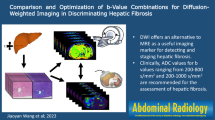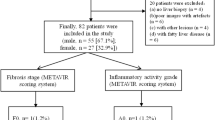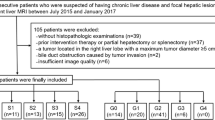Abstract
Objectives
To evaluate the usefulness of diffusion- weighted MRI (DWI) in the detection and staging of liver fibrosis and inflammation.
Methods
DWI was performed with b-factors of 0, 500 and 1000 s/mm². ADC values were obtained by placing circular regions of interest in four segments of the liver. Differences between the study (n = 34) and control groups’ (n = 25) ADC values were examined. Further, this study investigated if and how ADC values were related to fibrosis stages and histological activity index (HAI) scores.
Results
The mean ADC value of the liver was smaller in the study group compared with the control group (P < 0.001). Spearman rho correlation analyses showed lower ADC values were associated with higher fibrosis and HAI scores (P < 0.01). There were statistically significant differences in liver ADC values between each combination of fibrosis stages (e.g. stages 0 and 1, 0 and 2) except for stages 1 and 2.
Conclusions
ADC values prove to be a valuable technique for the diagnosis of liver fibrosis and inflammation. They can also be useful in fibrosis staging, particularly in distinguishing later stages of fibrosis from intermediate and early stages.
Key Points
-
Diffusion Weighted MRI is a promising technique for diagnosis of liver fibrosis.
-
Apparent Diffusion Coefficients provide valuable information for staging of liver fibrosis.
-
DWI may offer alternative to biopsy for assessing liver fibrosis.


Similar content being viewed by others
References
Malekzadeh R, Mohamadnejad M, Nasseri-Moghaddam S et al (2004) Reversibility of cirrhosis in autoimmune hepatitis. Am J Med 117:125–129
Wanless IR, Nakashima E, Sherman M (2000) Regression of human cirrhosis: morphologic features and the genesis of incomplete septal cirrhosis. Arch Pathol Lab Med 124:1599–1607
Dufour JF, DeLellis R, Kaplan MM (1998) Regression of hepatic fibrosis in hepatitis C with long-term interferon treatment. Dig Dis Sci 43:2573–2576
Rambaldi A, Gluud C (2005) Colchicine for alcoholic and non-alcoholic liver fibrosis and cirrhosis. Cochrane Database Syst Rev 2:CD002148
Safadi R, Zigmond E, Pappo O, Shalev Z, Ilan Y (2007) Amelioration of hepatic fibrosis via beta-glucosyl- ceramide-mediated immune modulation is associated with altered CD8 and NKT lymphocyte distribution. Int Immunol 19:1021–1029
Berg T, Sarrazin C, Hinrichsen H et al (2004) Does non-invasive staging of fibrosis challenge liver biopsy as a gold standard in chronic hepatitis C? Hepatology 39:1456–1457
Afdhal NH, Nunes D (2004) Evaluation of liver fibrosis: a concise review. Am J Gastroenterol 99:1160–1174
Kugelmas M (2004) Liver biopsy. Am J Gastroenterol 99:1416–1417
Vallet-Pichard A, Mallet V, Nalpas B et al (2007) FIB- 4: an inexpensive and accurate marker of fibrosis in HCV infection—comparison with liver biopsy and FibroTest. Hepatology 46:32–36
Ziol M, Handra-Luca A, Kettaneh A et al (2005) Noninvasive assessment of liver fibrosis by measurement of stiffness in patients with chronic hepatitis C. Hepatology 41:48–54
Rouvire O, Yin M, Dresner MA et al (2006) MR elastography of the liver: preliminary results. Radiology 240:440–448
Castera L, Vergniol J, Foucher J et al (2005) Prospective comparison of transient elastography, FibroTest, APRI, and liver biopsy for the assessment of fibrosis in chronic hepatitis C. Gastroenterology 128:343–350
Annet L, Materne R, Danse E, Jamart J, Horsmans Y, Van Beers BE (2003) Hepatic flow parameters measured with MR imaging and Doppler US: correlations with degree of cirrhosis and portal hypertension. Radiology 229:409–414
Hagiwara M, Rusinek H, Lee VS et al (2008) Quantification of liver fibrosis in patients with chronic liver disease using 3D perfusion-weighted MR imaging: preliminary experience. Radiology 246:926–934
Kwee TC, Takahara T, Ochiai R, Nievelstein RA, Luijten PR (2008) Diffusion-weighted whole-body imaging with background body signal suppression (DWIBS): features and potential applications in oncology. Eur Radiol 18:1937–1952
Kele PG, van der Jagt EJ (2010) Diffusion weighted imaging in the liver. World J Gastroenterol 16:1567–1576
Muraoka N, Uematsu H, Kimura H et al (2008) Apparent diffusion coefficient in pancreatic cancer: characterisation and histopathological correlations. J Magn Reson Imaging 27:1302–1308
Naganawa S, Sato C, Kumada H et al (2005) Apparent diffusion coefficient in cervical cancer of the uterus: comparison with the normal uterine cervix. Eur Radiol 15:71–78
Inci E, Hocaoglu E, Aydin S, Cimilli T (2011) Diffusion-weighted magnetic resonance imaging in evaluation of primary solid and cystic renal masses using the Bosniak classification. Eur J Radiol. doi:10.1016/j.ejrad.2011.02.024
Inci E, Kilickesmez O, Hocaoglu E, Aydin S, Bayramoglu S, Cimilli T (2011) Utility of diffusion-weighted imaging in the diagnosis of acute appendicitis. Eur Radiol 21:768
Girometti R, Furlan A, Bazzocchi M et al (2007) Diffusion-weighted MRI in evaluating liver fibrosis: a feasibility study in cirrhotic patients. Radiol Med 112:394–408
Moteki T, Horikoshi H (2006) Evaluation of hepatic lesions and hepatic parenchyma using diffusion weighted echo-planar MR with three values of gradient b-factor. J Magn Reson Imaging 24:637–645
Namimoto T, Yamashita Y, Sumi S, Tang Y, Takahashi M (1997) Focal liver masses: characterisation with diffusion-weighted echo-planar MR imaging. Radiology 204:739–744
Ichikawa T, Haradome H, Hachiya J, Nitatori T, Araki T (1998) Diffusion-weighted MR imaging with a single-shot echoplanar sequence: detection and characterization of focal hepatic lesions. AJR Am J Roentgenol 170:397–402
Taouli B, Tolia AJ, Losada M et al (2007) Diffusion weighted MRI for quantification of liver fibrosis: preliminary experience. AJR Am J Roentgenol 189:799–806
Lewin M, Poujol-Robert A, Boelle PY et al (2007) Diffusion- weighted magnetic resonance imaging for the assessment of fibrosis in chronic hepatitis C. Hepatology 46:658–665
Sandrasegaran K, Akışık FM, Lin C, Tahir B, Rajan J, Saxena R, Aisen AM (2009) Value of diffusion-weighted MRI for assessing liver fibrosis and cirrhosis. AJR Am J Roentgenol 193(6):1556–60
Soylu A, Kılıçkesmez Ö, Poturoğlu Ş, Dolapçıoğlu C, Serez K, Sevindir İ, Yaşar N, Akyıldız M, Kumbasar B (2010) Utility of diffusion-weighted MRI for assessing liver fibrosis in patients with chronic active hepatitis. Diagn Interv Radiol 16:204–208
Koinuma M, Ohashi I, Hanafusa K, Shibuya H (2005) Apparent diffusion coefficient measurements with diffusion-weighted magnetic resonance imaging for evaluation of hepatic fibrosis. J Magn Reson Imaging 22:80–85
Boulanger Y, Amara M, Lepanto L et al (2003) Diffusion-weighted MR imaging of the liver of hepatitis C patients. NMR Biomed 16:132–136
Knodell RG, Ishak KG, Black WC et al (1981) Formulation and application of a numerical scoring system for assessing histological activity in asymptomatic chronic active hepatitis. Hepatology 1:431–435
Author information
Authors and Affiliations
Corresponding author
Rights and permissions
About this article
Cite this article
Bakan, A.A., Inci, E., Bakan, S. et al. Utility of diffusion-weighted imaging in the evaluation of liver fibrosis. Eur Radiol 22, 682–687 (2012). https://doi.org/10.1007/s00330-011-2295-z
Received:
Revised:
Accepted:
Published:
Issue Date:
DOI: https://doi.org/10.1007/s00330-011-2295-z




